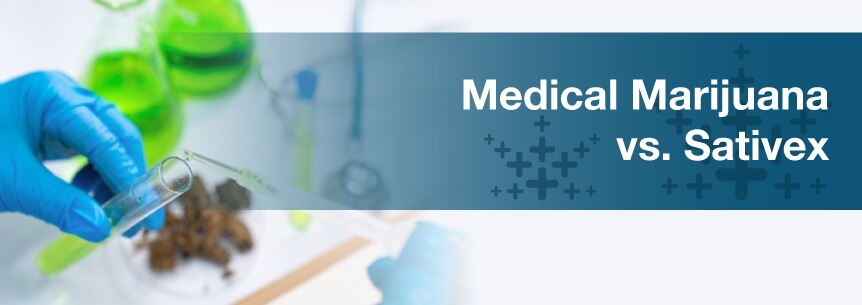
If you’ve been diagnosed with multiple sclerosis (MS), you may have heard of Sativex, and you probably have questions about this drug. You may also wonder how it differs from other cannabis medications. In this guide, we’ll explore the pros and cons of Sativex, how it compares to non-pharmaceutical marijuana products and available Sativex alternatives. Although Sativex and medical marijuana are similar in many ways, one may be better than the other depending on your symptoms.
According to GW Pharmaceuticals, Sativex is an oromucosal spray consisting of an extract from the cannabis sativa plant. Although Sativex is manufactured in a controlled laboratory setting, it does not contain synthetic cannabinoids.
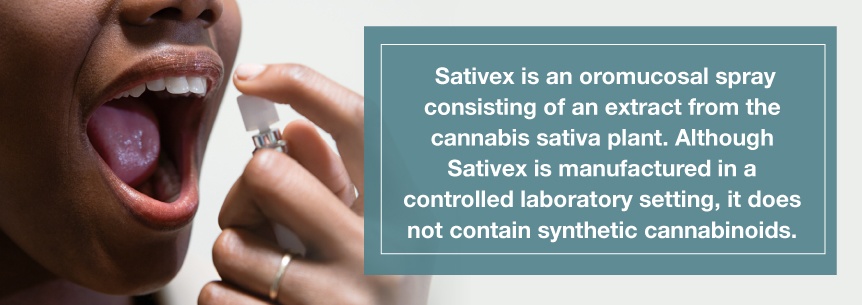
Sativex mainly includes a 1-1 ratio of delta-9-tetrahydrocannabinol (THC) and cannabidiol (CBD). Other ingredients include specific cannabinoids and inactive ingredients such as ethanol, propylene glycol and peppermint oil.
Although Sativex mostly consists of natural marijuana ingredients, it is not the same as other cannabis products. Sativex is different than medical marijuana because:
GW Pharmaceuticals developed Sativex as the world’s first prescription cannabis-derived medicine.
Sativex, also known as nabiximols, was developed to treat spasticity. Spasticity is a common MS symptom which causes muscle stiffness and affects more than 80 percent of MS patients. Doctors may recommend Sativex when other MS treatments do not work. However, Sativex may be taken with other MS medications.
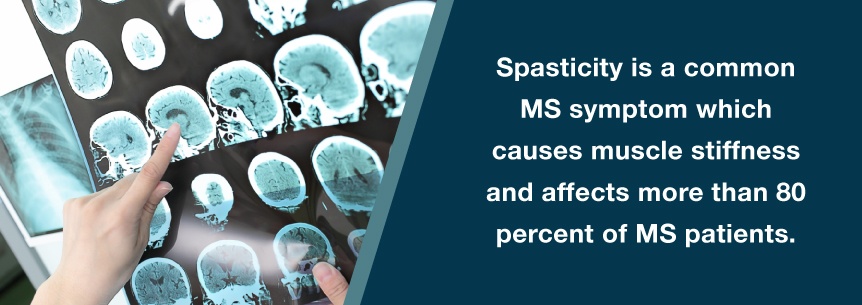
According to the National Multiple Sclerosis Society, more than 2.3 million people are affected by MS worldwide. Symptoms vary between individuals, but in general, MS causes damage to the central nervous system which can affect just about every part of the body. Patients commonly complain of extreme fatigue, visual disturbances and mobility difficulties. There is no cure for MS, so patients focus on relieving symptoms. When conventional medications do not work, marijuana products offer an alternative.
Sativex comes in a small vial. Patients spray the liquid under their tongue or inside their cheeks. They gradually increase the dose every day until they reach the optimal amount for symptom relief.
A qualified doctor will recommend how much Sativex to take depending on the individual and their symptoms. However, the maximum dose is 12 sprays per day. Doctors usually prescribe Sativex for a trial period of four weeks. If it does not work within that time, treatment is discontinued.
Several studies have shown that Sativex is probably an effective treatment for MS. For example, one clinical trial which examined the effects of Sativex in over 500 people found a 20 percent improvement in 48 percent of participants regarding spasticity.
Another study published in 2016 found that 70.5 percent of patients improved during a one month period. Lastly, a study published by the American Academy of Pain Medicine concluded that after one month of Sativex administration, MS patients experienced reduced pain and improved quality of life. Overall, numerous studies have found that Sativex may be a useful and safe option for MS patients with moderate to severe spasticity who do not respond to common MS treatments.
Researchers are not yet sure exactly how Sativex relieves nerve pain. However, it is thought that Sativex works by activating cannabinoid receptors throughout the central nervous system to reduce neuropathic pain and inhibit muscle spasms.
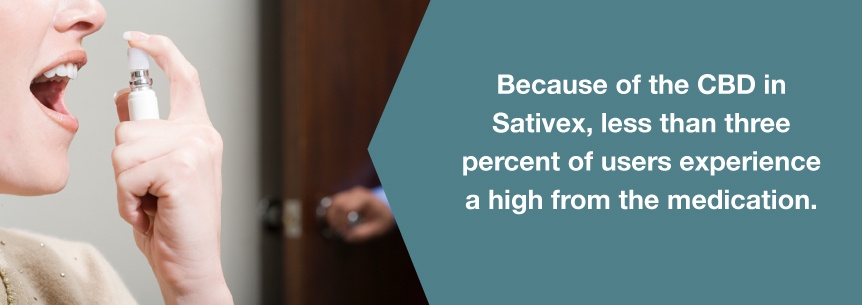
The main ingredients in Sativex – CBD and THC – provide the effects. CBD is known to help reduce pain and inflammation and does not get users high. THC is associated with reducing pain and nausea, increasing appetite and causing a euphoric mood. When THC and CBD are used together, they often complement each other. For example, CBD reduces the unwanted psychoactive effects of THC for many patients. Because of the CBD in Sativex, less than three percent of users experience a high from the medication.
Sativex is gaining attention around the world as a useful treatment for MS. However, like most medications, Sativex has certain drawbacks such as the following:
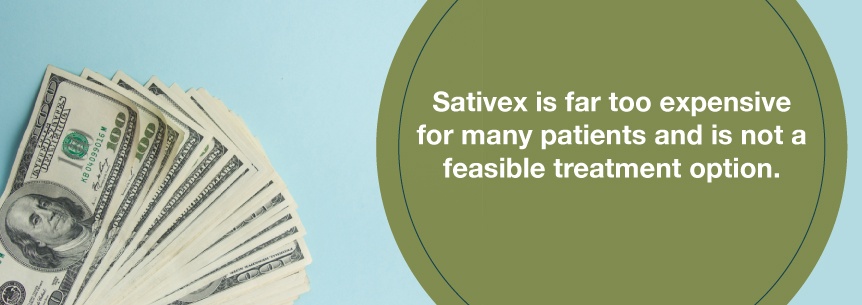
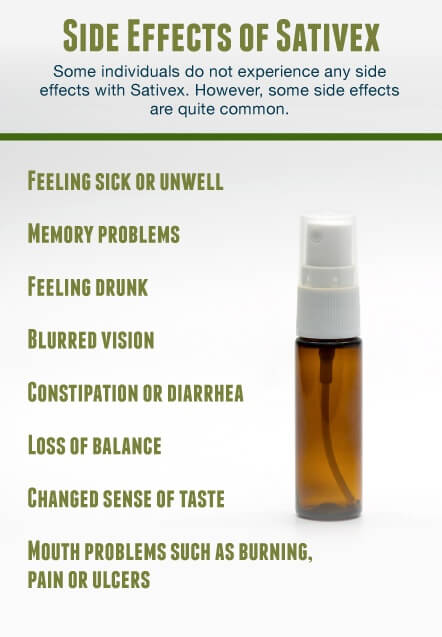
Some individuals do not experience any side effects with Sativex. However, some side effects are quite common. For example, more than one in 10 people experience dizziness or tiredness as a result of Sativex. Other common side effects include:
Uncommon side effects include:
Cannabis products, such as Sativex, are considered a Class B drug in the U.K. and could result in up to five years in prison, fines or both if Sativex is not used lawfully. Sativex can only be possessed with a doctor’s prescription.
Currently, Sativex is available as a prescription medicine in the U.K., Canada, several European and South American countries, Australia and New Zealand. Sativex is not yet available in the U.S. or approved by the Food and Drug Administration (FDA). However, Sativex is currently being studied as a treatment for patients with advanced cancer in the U.S.
In the U.K., Sativex may only be prescribed by a doctor who specializes in treating MS spasticity. It is also limited to patients who respond to treatment within the first four weeks of administration.

Although Sativex is not yet available in the U.S., medical marijuana patients can ask their doctor about Sativex alternatives.
As mentioned above, patients need a doctor’s prescription to obtain Sativex in the U.K. If Sativex becomes available in the U.S., patients would need to look up the medical marijuana laws within their state or speak with their doctor before taking the next step. In many states, you must have a qualifying condition to be eligible for a medical marijuana card. MS is usually considered a qualifying condition. Because laws vary between states and because marijuana is still illegal on a federal level, it’s always best to research your specific state laws.
Although a pharmaceutical company had developed Sativex, it is still mostly composed of natural plant ingredients. Just like other cannabis products, Sativex contains THC and CBD. Except for ethanol, propylene glycol and peppermint oil, Sativex is similar to other cannabis liquids. Ethanol is alcohol, and propylene glycol is a synthetic food additive.
However, many differences still exist between Sativex and other marijuana medications. For example, some marijuana products contain high THC levels and low CBD levels and vice versa. Sativex consists of a 1-1 ratio in every bottle.
Patients who do not want to experience the psychoactive effects of THC might prefer a CBD-only product. Patients who enjoy psychoactive effects may choose marijuana medications with higher levels of THC over Sativex. THC is the main chemical in the cannabis plant, and it’s associated with the following benefits:
Some patients may benefit more from a higher level of CBD rather than an equal ratio. Those who want to reduce stress, pain, anxiety and insomnia without the high associated with THC might choose a medication high in CBD.

Because Sativex is standardized, some patients will not be able to escape common side effects while still relieving nerve-related pain. With other marijuana products, patients enjoy greater flexibility to find a dose, strain and method of consumption that suits their medical needs.
Considering the efficacy of Sativex, you may be disappointed it is not available to MS patients in the U.S. However, that does not mean patients cannot benefit from medical cannabis. Other cannabis medications may prove to be even more beneficial than Sativex. MS affects individuals differently, so a standard medicine like Sativex may be limiting when it comes to relieving a range of symptoms. Here are reasons to consider marijuana alternatives to Sativex:
Sativex mouth spray takes longer to kick in than other methods of cannabis consumption. MS spasticity can be extremely painful for some patients. In such a case, they’ll likely want fast relief. Inhaling cannabis is the quickest way to get cannabinoids in your system and to your brain to feel pain-relieving effects.
According to Neurology Reviews, about 46 percent of MS patients choose to smoke marijuana for pain, tremor, insomnia, bladder issues or spasticity. One clinical trial found that smoking cannabis decreased pain intensity by at least 30 percent for all patients.
There are far more cannabinoids in the marijuana plant than just THC and CBD. When the plant is manufactured in a lab and produced to be exact every time, patients may miss out on additional healing properties of the plant as its found in nature. For example, when a patient takes Sativex, they miss out on experiencing terpenes.
Terpenes are the aromatic oils on the marijuana plant that give cannabis it’s potent flavor and fragrance. Terpenes may offer unique medicinal benefits for some patients. For example, the terpene limonene which has a citrusy scent may function as an antidepressant and digestive aid. Myrcene, the most prevalent terpene, offers sedative and antiseptic properties, among others. Many patients enjoy terpenes as part of the cannabis experience.
Some patients may not want to risk irritating their mouths which is a possibility with Sativex. They might prefer to inhale or eat marijuana instead. They can also use lotions or oils to apply marijuana medicine to sore muscles which they cannot do with Sativex. Considering that Sativex is a spray, patients are limited in how they can take their medication.
Sativex does not offer some of the unique benefits of different marijuana strains. Different strains relieve a variety of symptoms at once, whereas Sativex is known to only be effective at relieving a few MS symptoms.
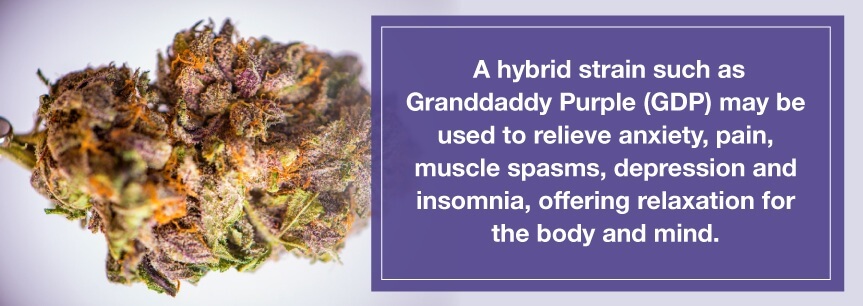
For example, some MS patients may experience anxiety alongside physical pain. A hybrid strain such as Granddaddy Purple (GDP) may be used to relieve anxiety, pain, muscle spasms, depression and insomnia, offering relaxation for the body and mind. Instead of needing to purchase multiple medications in addition to Sativex, patients may find that GDP is all they need to find relief.
Many patients would prefer to consume marijuana that had not been produced by a large pharmaceutical company. A survey of almost 1,000 medical marijuana patients found that they prefer their medicine as it’s found in nature and not as a pharmaceutical company product. This worldwide survey evaluated patients’ perceptions of different cannabis products and their preferred methods of consumption. Overall, survey participants said the herbal preparations of the plant were more cost-effective and had fewer side effects, and they derived greater satisfaction from inhaling cannabis compared to taking medication orally.
A report published in 2017 found that up to 60 percent of MS patients already use marijuana, and up to 90 percent would consider marijuana products if it were legal and more scientific evidence was available. A recent online survey showed that about 50 percent of individuals with MS use cannabis without a medical marijuana card.
Perhaps the greatest reason to choose marijuana over Sativex is cost. Sativex is simply unaffordable for many patients. For example, in New Zealand, Sativex may cost $1,100 to $1,400 per month depending on the dose. In the U.K., a standard bottle, which contains about 90 doses, costs about $182 U.S. dollars. If a patient takes 12 sprays a day, they’ll be needing more medication in about a week.
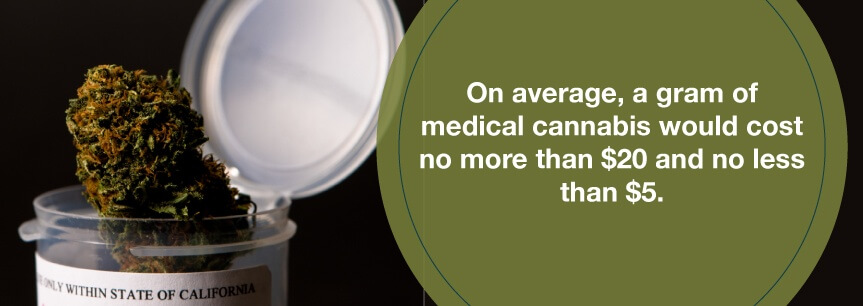
Other forms of cannabis medication are more affordable. On average, a gram of medical cannabis would cost no more than $20 and no less than $5. A bottle of tinctures costs around $20 to $40. Marijuana can last much longer than an opened vial of Sativex as well. Properly stored weed can last for years with minimal THC loss. Depending on how much a patient needs to experience symptom relief, other methods of consumption can be much more cost-effective.
Sativex is not available to patients in the United States. However, medical marijuana is available in most states. Qualifying patients all over the country can choose cannabis medications that relieve their MS symptoms.
Medical marijuana can help MS patients as much, if not more so, than Sativex. The cannabinoids in the marijuana plant may help with muscle stiffness, spasms, inflammation, pain, sleep issues and depression commonly experienced by MS patients. If they wish, qualifying patients can speak with their doctor about obtaining marijuana products with a similar CBD to THC ratio as Sativex.
If you’re looking for an alternative treatment for MS, know that there are options available to you if medical marijuana is legal in your state. Cannabis has been shown to relieve a vast array of symptoms. At MarijuanaDoctors.com we are here to help connect you to compassionate cannabis-certified doctors who can recommend the right type of marijuana for your condition.
As a medical marijuana patient, you can discuss the different methods of consumption with your doctor and determine whether you prefer to inhale, eat or drink your medication. You can also discuss how cannabis can treat other symptoms associated with MS such as insomnia or depression.
If you’re not sure where to begin, use this site to help you get started. Our resources can point you in the right direction from showing you your state laws to guiding you through the process of obtaining a medical marijuana card and connecting you to a doctor or dispensary. All of the information you need to start medical marijuana treatment is here in an easy-to-read format, so you can focus on feeling better and gaining control of your symptoms.
To get started, search for a medical marijuana doctor today or sign up for our free monthly newsletter and stay on top of the latest medical cannabis news.
Find A Doctor Find A Dispensary
No Information on MarijuanaDoctors.Com should be used to diagnose, treat, prevent or cure any disease or condition. You can view our Full Disclaimer here.